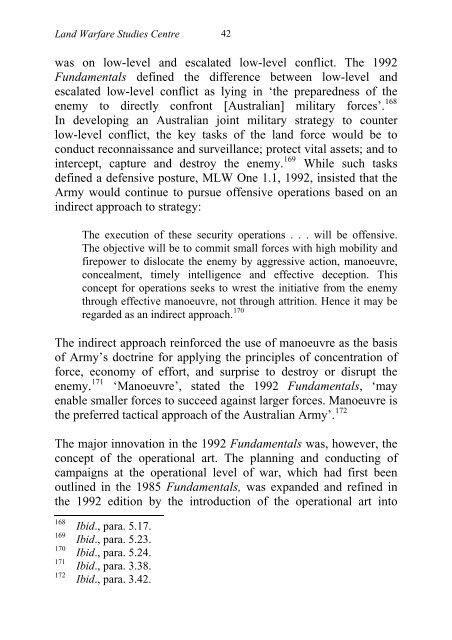Ibid - Australian Army
Ibid - Australian Army
Ibid - Australian Army
Create successful ePaper yourself
Turn your PDF publications into a flip-book with our unique Google optimized e-Paper software.
Land Warfare Studies Centre 42<br />
was on low-level and escalated low-level conflict. The 1992<br />
Fundamentals defined the difference between low-level and<br />
escalated low-level conflict as lying in ‘the preparedness of the<br />
enemy to directly confront [<strong>Australian</strong>] military forces’. 168<br />
In developing an <strong>Australian</strong> joint military strategy to counter<br />
low-level conflict, the key tasks of the land force would be to<br />
conduct reconnaissance and surveillance; protect vital assets; and to<br />
intercept, capture and destroy the enemy. 169 While such tasks<br />
defined a defensive posture, MLW One 1.1, 1992, insisted that the<br />
<strong>Army</strong> would continue to pursue offensive operations based on an<br />
indirect approach to strategy:<br />
The execution of these security operations . . . will be offensive.<br />
The objective will be to commit small forces with high mobility and<br />
firepower to dislocate the enemy by aggressive action, manoeuvre,<br />
concealment, timely intelligence and effective deception. This<br />
concept for operations seeks to wrest the initiative from the enemy<br />
through effective manoeuvre, not through attrition. Hence it may be<br />
regarded as an indirect approach. 170<br />
The indirect approach reinforced the use of manoeuvre as the basis<br />
of <strong>Army</strong>’s doctrine for applying the principles of concentration of<br />
force, economy of effort, and surprise to destroy or disrupt the<br />
enemy. 171 ‘Manoeuvre’, stated the 1992 Fundamentals, ‘may<br />
enable smaller forces to succeed against larger forces. Manoeuvre is<br />
the preferred tactical approach of the <strong>Australian</strong> <strong>Army</strong>’. 172<br />
The major innovation in the 1992 Fundamentals was, however, the<br />
concept of the operational art. The planning and conducting of<br />
campaigns at the operational level of war, which had first been<br />
outlined in the 1985 Fundamentals, was expanded and refined in<br />
the 1992 edition by the introduction of the operational art into<br />
168<br />
169<br />
170<br />
171<br />
172<br />
<strong>Ibid</strong>., para. 5.17.<br />
<strong>Ibid</strong>., para. 5.23.<br />
<strong>Ibid</strong>., para. 5.24.<br />
<strong>Ibid</strong>., para. 3.38.<br />
<strong>Ibid</strong>., para. 3.42.

















